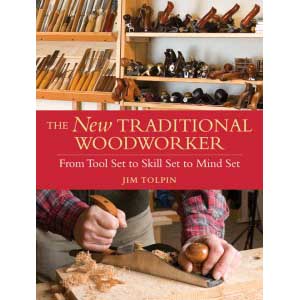
Book Review: Jim Tolpin's The New Traditional Woodworker
by J. Norman Reid
Delaplane, Virginia
The current revival of interest in hand tools has summoned forth a number of good books to ease the transition away from power tools. One of the best—if not the best—is Jim Tolpin's The New Traditional Woodworker.
Tolpin covers a lot of ground in this essential work. In fact, his subtitle says it all: From Tool Set to Skill Set to Mind Set. He starts with an overview of the decisions that need to be made in setting up a hand tool woodshop and designing a workbench. This section is a basic overview that will be of most use to those just starting out. More in-depth treatments of these subjects are available elsewhere.
Tolpin reserves a much larger section to review the wide range of tools that have a place in a hand tool-oriented shop. For the uninitiated, this provides an essential scoping of the subject area and introduces tools that may well be unfamiliar, despite their usefulness. Again, this is more of an overview than an in depth treatment on the topic. You will want to look to other sources more in depth reviews of many hand tools—especially hand planes.
A unique part of Tolpin's book is a short section on the shift in mindset that facilitates hand tool-oriented woodworking. Among the principles Tolpin emphasizes are getting and keeping sharp tools, finding the simplest way to complete a task, working from coarse to fine, knowing when "good enough is good enough," minimizing mistakes and using geometry to trump arithmetic.
The lion's share of the book is given over to the construction—by hand, of course—of a variety of tools and fixtures that play important roles in a hand tool woodshop. Among these are a straight edge, try squares, winding sticks, a face planing stop, bench hooks, an edge planing stop, a sticking board, workbench tote, saw benches and bows for drawing arcs. Each project is designed to develop hand tool skills that build on each other as you progress through the projects. Often, tools built earlier are used in creating later projects. Each project is carefully described from initial design to finishing and is amply illustrated with excellent photographs of construction steps.
This extremely well-written book uses a pleasant conversational style that made me feel right at home in adding hand tool techniques to my woodworking procedures. Already I've built three of the shop projects and eagerly look forward to more.
Woodworkers who are starting out with hand tools, making the transition to a hand tool woodshop or wanting to make more use of hand tools to supplement their power tools will find this book to be a valuable resource. Likewise, the armchair woodworker seeking an interesting read will find a good one here. And, woodworkers who already have some hand tool experience who seek to strengthen their hand tool skills and tool collection will find inspiration and solid advice.
Purchase your own copy of
The New Traditional Woodworker
The author is a woodworker, writer and photographer living in Delaplane, Virginia, in the foothills of the Blue Ridge Mountains with his wife, four cats and a woodshop full of power and hand tools.
He can be reached by email at
nreid@fcc.net
.
Return to
Wood News
front page
